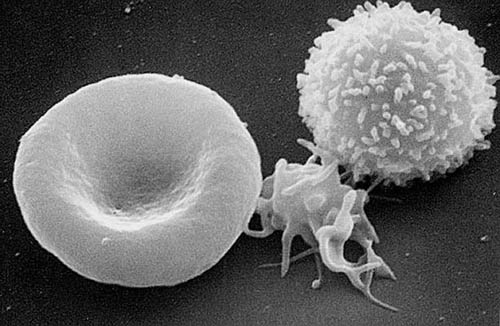Immune cells advance along the blood vessels by means of invasive foot-pegs

When various bacteria, viruses or parasites enter the body, the damaged tissue sends out a "distress call" to recruit the white blood cells - the body's medical corps, patrolling the blood vessels. The reading causes the appearance of special adhesion molecules on the endothelial cells lining the blood vessels. These molecules function as "traffic signals" that signal the white blood cells to slow down and adhere to the blood vessel wall. After adhering, the white blood cells "crawl" along the blood vessel wall, looking for a place where they can cross the endothelial cells and enter the damaged tissue - to destroy the invader. It is a fast crawl, under difficult conditions: every minute the cells move a distance equal to their length, when the forces of blood flow threaten to detach them from their grip. How do the white blood cells manage to cling to the endothelial cells, move quickly along them, find a convenient point of passage - and all this without tearing off and being swept away in the bloodstream?
Prof. Ronan Alon and research student Ziv Shulman from the Department of Immunology at the Weizmann Institute of Science recently published in the journal Immunity new and revolutionary findings on the way white blood cells progress along the endothelial cells. The prevailing opinion until recently was that immune cells progress like a worm: the cells stick to the blood vessels through two main grip areas, front and back, which allow them to move through cyclical folding and unfolding. The findings of the new study show that the rapid movement of white blood cells is more similar to the crawling of millipedes: the cell creates dozens of grip points rich in specific adhesion molecules, which bind appropriate molecules displayed on the surface of the blood vessel wall. Each such holding point functions as a tiny independent leg - its size does not exceed that of a single micron - which attaches and detaches in a few seconds. The attachment and detachment of dozens of these legs occur in a sequential manner - which allows for rapid movement and a stable grip at the same time.
In order to better understand how these special legs function, the scientists turned to the electron microscopy unit at the Weizmann Institute of Science. Images taken using a scanning and penetrating electron microscope, by Dr. Eugenia Klein and Dr. Vera Schindler, showed that upon adhering to the blood vessel wall, the immune cell sends legs into the body of the endothelial cell. The researchers discovered that these extensions stick like tiny drills in the endothelial cells already during the crawling and even before it crosses into the inflamed tissue - contrary to the conventional approach, according to which the white blood cell movement in the endothelial cells takes place only during the crossing of the blood vessel wall.
In addition, these legs are formed only when the shearing forces created by the blood stream are applied to the white blood cells. In the absence of these forces, the white blood cells did not send infiltrative legs into the endothelial cells, and therefore were unable to penetrate through the vessel wall. It was also discovered that the formation of the penetrating legs is accompanied by rapid and reversible changes in the intracellular skeleton of the immune cell and the endothelial cell. The researchers believe that the tiny legs are used for holding, crawling and scanning the surface area of the blood vessel wall, in order to locate a suitable crossing point. So, for example, it is possible that in response to the pinching of the legs, the endothelial cell softens its membrane to allow a more efficient search for a suitable crossing point. Another possibility is that each of these tiny legs serves as a sensor that picks up the recruitment signals secreted by the damaged tissue, thus directing the white blood cell to reach the site of inflammation.
Next, the scientists plan to test whether it is possible to regulate severe inflammatory reactions (such as those characteristic of autoimmune diseases) by interfering with the formation of the infiltrating legs. Another question is, do cancerous blood cells that migrate in the bloodstream, use similar migration mechanisms to leave the blood vessels and enter different tissues, thus creating cancerous metastases.

6 תגובות
Now girls' endothelial cells will start suing white blood cells for sending them legs and sexually harassing them. And judging by the current pathetic public mood, they will also win the trial
Alikin:
True but it doesn't belong.
After all, Yuval did not propose that cells developed into nerves thanks to their immune ability but thanks to sending their legs.
Michael R.
But primitive life forms that lack nerve cells have immune cells/organelles.
jubilee:
Does not seem likely.
It is written that the cells send legs (not like people who send hands) only when the shearing pressure of the blood is applied to them and in the absence of such pressure they do not do so.
Nerve cells do not begin their journey in the blood.
More than that - I wouldn't be surprised (although I haven't checked) if the nervous system was evolutionary ahead of the blood system (the nervous system is very similar in all animals we have it - unlike the "blood" system)
White blood cells need to pass through the bloodstream to the inflammatory site, so in order to integrate they use the legs.
Red blood cells integrate into the bloodstream so logic says they don't need legs. I would actually check what would have happened if red blood cells (and possibly cancerous) were introduced into the lymphatic system, the question then is what would happen, then how would they cross..
Could it be that these legs developed later in evolution into electrically conductive extensions and thus to create neurons?